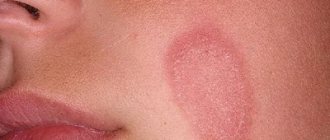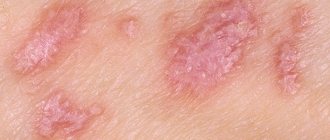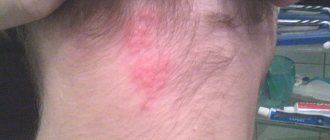Causes of development of ringworm
Since this is a mycosis, the etiology of its development is fungi.
In nature, there are two genera of fungi known to cause ringworm: the genus Trichophyton (translated from Greek as “growing in hair”) and the genus Microsporum. Hence two other scientifically based names for the disease: trichophytosis and microsporia. Children become infected by contact with a sick person, or by using his personal belongings (headdress, comb, bed linen, scissors). But most often, children become infected from pets - cats or dogs, which serve as carriers of the disease. You can also get the fungus and become infected by visiting hairdressers, kindergartens, schools, gyms, swimming pools and other public places where sanitary and hygienic standards are not observed.
From the moment of infection to the onset of the disease, it can take from 3 to 7 days. This period, when the child is already sick, but there are no manifestations yet, is called the incubation (hidden) period.
For infection, the general condition of the body is of great importance. Children who have a weakened immune system get sick much more often.
Types of ringworm
By type of pathogen:
- Ringworm caused by fungi of the genus Trichophyton, or trichophytosis.
- Ringworm caused by fungi of the genus Microsporum, or microsporia.
According to the manifestations of the disease:
- Surface form.
- A chronic form, which also includes nail damage.
- Infiltrative-suppurative form.
By location of the lesion:
- Ringworm affecting smooth skin.
- Ringworm affecting the scalp.
Chronic trichophytosis.
This is the result of untreated trichophytosis. Among adults, only women who were not treated for the superficial form in childhood suffer from the chronic form. Since the hair of healthy adults contains organic acids that protect against fungal damage, the chronic form develops in people with endocrine diseases and weakened immunity. Women with the chronic form serve as a source of infection and spread of the disease among children.
The deep, or infiltrative-suppurative form is observed mainly among residents of rural areas. People become infected when working with sick animals, most often cattle. But other animals, such as cats, can also become a source of infection. This form occurs with equal frequency in both children and adults.
Main manifestations of ringworm
Signs of superficial form of lichen on the head
- The superficial form of ringworm, which occurs in the area of the scalp, is manifested by foci of different sizes, oval, round or having clear boundaries.
- The hair in the outbreak is broken off and falls out. Hair affected by the fungus is dull and thickened, and hair broken off at skin level appears as black dots (they are also called “stumps”). Some “stumps” of broken hair protrude above the skin, and it seems as if the hair in this area was trimmed at the same level.
- The skin of the affected area is covered with gray and white scales, similar in appearance to dandruff, and flakes off without causing any sensation to the patient.
- If left untreated, the lesions grow and can become quite large. Redness of the affected area of the skin is observed, along the edges of which a rim of small bubbles appears; the bubbles, bursting, dry out and become covered with yellow crusts.
- Although the patient does not have any unpleasant sensations, due to the unkempt appearance of the hair on the head, many people experience discomfort, especially children. After all, the appearance of lichen and bald spots on the head can become a reason for jokes and ridicule from peers.
Signs of ringworm on smooth skin
- The superficial form is characterized by the appearance of round or oval lesions, spots that have clear boundaries and are surrounded by a red ridge. The roller is formed by bubbles and crusts, it is thickened and rises slightly above the surface of healthy skin.
- Inside the roller, the skin is light and covered with gray small scales.
- When lesions appear on smooth skin, they are usually larger than on the head, and when they merge, they form extensive pink, slightly flaky lesions, with uneven, blurred edges.
- Lesions can appear throughout the body, affecting any area of the skin, but the most favorite places for ringworm to localize are the skin of the face and neck.
- Skin affected by ringworm itches, causing discomfort.
Signs of chronic ringworm
- Lesions can be located on the head, in different areas of smooth skin, and fingernails and toenails are often affected.
- The disease manifests itself in the presence of small atrophic bald patches with scars on the scalp, as well as hair broken off at the very root, reminiscent of black dots.
- Round bald spots are usually located on the temples and back of the head. The scalp may become flaky, but the flaking is usually minor. As a rule, the manifestations of the disease do not cause any discomfort; only a small number of patients may experience mild itching.
For this reason, the disease often goes undetected and untreated, lasting for many years, spreading among healthy people. Children are most often infected.
- On smooth skin, the chronic form manifests itself in characteristic lesions with uneven, unclear boundaries. The lesions are located mainly on the skin of the buttocks, in the area of the knee joints, the inner surface of the thighs and forearms, but it is possible that lesions may appear in other areas. The lesions are red or pinkish-bluish in color, with slight peeling on the surface.
- Most patients with chronic trichophytosis experience nail damage. First of all, fungi affect the fingernails, and then the toenails. When affected by fungi, the nails gradually become dirty gray, thicken or thin, crumble, look dull and uneven.
In patients with significant disturbances in the functioning of the immune system, common forms of trichophytosis may occur, when fungi affect internal organs. Fortunately, this phenomenon is extremely rare.
Signs of infiltrative-suppurative form of ringworm
- Dark red round formations appear on the affected skin, protruding above the skin. They are located under the hair, most often on the head; in men, formations can appear on the beard and mustache. At first, the elements are dense and painful when you touch the affected area, then they soften and become covered with crusts on top. When the scabs fall off, there is a discharge of pus from the areas where the hair grows.
- The patient's general well-being may be impaired, which is accompanied by a rise in temperature. The patient experiences headaches and malaise, and an allergic rash appears on the skin. There is also an increase in lymph nodes located close to the lesion.
- Oddly enough, the disease can go away on its own, without treatment. But then scars will remain at the site of the lesion.
Symptoms and complications
This lichen is called ringworm because when it is infected, the hair on the head breaks off at a distance of about half a centimeter from the skin and appears as if it has been cut off. As a result, bald spots are formed and increase in size. Reddish spots with a bright ridge around the circumference form on the body, vellus hair breaks off at the site of the lesion, turning into nodules. It creates the feeling of a seal placed on the skin.
In people with weakened immunity and severe concomitant diseases, severe forms of trichophytosis occur:
- Infiltrative
, in which gray swollen spots appear on the skin, quickly increasing in size. The patient's temperature rises and the lymph nodes in the affected area become enlarged. - Purulent
, characterized by deep skin lesions with the release of pus and the appearance of ulcers on the surface of the lichen. Sometimes purulent contents appear in the form of yellow cloudy drops. Patients' general condition worsens, their temperature rises, and their lymph nodes become enlarged. Without treatment, blood poisoning may occur.
The fungus can affect various parts of the body, including the arms, legs, and face. Foci of the disease also form on the scalp, and in men - in the area of the mustache and beard. The disease often affects the nails, and the hands and feet may also be affected. Particularly unpleasant sensations are caused by the formation of plaques in the armpits or in the groin folds.
Ringworm is characterized by symptoms such as:
- burning and itching in the affected area;
- swelling, pain, purulent discharge that occurs in advanced cases;
- dandruff and focal baldness when spots are localized in the hairline area;
- general weakness and malaise.
In children, during exacerbation of the disease, episodes of fever, enlarged lymph nodes, and disturbances in the functioning of the digestive system are common. If the treatment is not started in a timely manner or is chosen incorrectly, the disease can become chronic.
Treatment of ringworm in children
The basis of treatment for ringworm is to destroy the fungus that causes the disease. Treatment is prescribed by a dermatologist.
When smooth skin is affected by fungi, local, external antifungal drugs are prescribed.
When there are many lesions on the skin and vellus hair is affected, as well as the skin and hair on the head, a complex treatment is prescribed, which, in addition to the local antifungal drug, also includes systemic agents.
Local treatment of ringworm
- To speed up the removal of fungi and their spores, it is necessary to shave off the affected hair once a week.
- Creams, ointments, gels, lotions, and shampoos containing antifungal agents, such as Exoderil cream, are prescribed. To treat nail plates, a special varnish with an antifungal agent in its composition can be used.
- In the morning, the lesions are treated with a 5% iodine solution, and in the evening, sulfur-salicylic or sulfur-tar ointment is applied.
Systemic treatment of ringworm includes the appointment of Griseofulvin, for oral administration, at the rate of 18 mg per kg of child’s body weight per day. The daily dosage is divided into three doses. It is recommended to take the drug every day with a teaspoon of regular vegetable oil. The course of treatment continues until the first negative test taken from the site of the lesion. Then the drug is taken in the same dosage, but every other day for another two weeks, and then twice a week until the end of treatment.
An alternative drug for the treatment of ringworm in children is Terbinafine. It is prescribed in tablets for children who weigh more than 40 kg - 250 mg, those weighing from 20 to 40 kg - 125 mg, and those weighing less than 20 kg - 62.5 mg. It is recommended to take the drug daily, after meals, once a day, for 5 - 6 weeks.
For the treatment of chronic forms, along with antifungal drugs, a complex of vitamins, immunomodulators and drugs that improve microcirculation are prescribed.
Treatment is stopped after three negative tests taken in case of damage to the scalp, once, for 7 - 10 days, and in case of damage to smooth skin - once a week.
Due to the possibility of developing relapses (repeated episodes of the disease), after completion of treatment, children are under the supervision of a dermatologist for three months if the hair on the head was affected; and one month if smooth skin was affected.
A control examination for children under observation is carried out once a month if the lichen was on the head; and once every 10 days if on smooth skin.
In some cases, hospital treatment may be required.
Indications for hospitalization are:
- lack of positive effect from treatment carried out at home;
- infiltrative-suppurative form;
- presence of severe concomitant diseases;
- the possibility of isolating sick children from healthy ones in boarding schools, hostels and large families.
- Gallery
- Reviews
- Articles
- Licenses
- Vacancies
- Insurance partners
- Partners
- Controlling organizations
- Schedule for receiving citizens for personal requests
- Online consultation with a doctor
- Documentation
This is a skin and hair disease caused by fungi of the genus Microsporum. This disease is highly contagious.
Children aged 4-11 years old are more likely to get sick, this is due to the fact that children under 2 years of age and adults have an acidic sweat reaction, and acid prevents fungi from multiplying. But with a decrease in immunity, if there are microtraumas on the skin (scratches, abrasions), anyone can become infected, regardless of age.
Infection occurs from animals (cats and dogs), which may have manifestations of the disease or may be carriers of the infection without obvious manifestations, and from people who have manifestations of the disease. Moreover, you can become infected both through direct contact with an infected animal or person, and through objects and things contaminated with skin flakes or hair (fur) containing the pathogen.
When infected, round pink or red lesions with a clear boundary appear on the skin, which quickly increase in size and number. Over time, they fade in the center, while a brighter rim remains along the edge, the lesions resemble rings. On the surface of the lesions, whitish or grayish peeling and crusts are observed, and there may be bubbles with liquid. If the process is localized on the scalp, then in the foci under the influence of a fungal infection, the hair breaks off at a height of 3-5 mm (which is why the disease is popularly called “ringworm”), and bald spots are formed. Subsequently, the lesions can merge with each other, forming intricate patterns; infected skin flakes can again fall on the skin in the center of the ring, which leads to the formation of a new lesion - a “ring within a ring”. The rashes are most often accompanied by itching and cause discomfort to the baby.
The diagnosis of microsporia can only be made by a pediatric dermatologist; to do this, you first need to take a scraping and culture from the lesions on the skin for fungi. Some other skin diseases, such as atopic dermatitis, eczema, psoriasis, may have similar manifestations, so treatment is prescribed only after receiving tests. If you suspect ringworm, immediately contact a pediatric dermatologist; do not self-medicate, as the tests will be unreliable.
Treatment for microsporia is quite long. The duration depends on the number and size of the lesions, as well as on whether the hair is affected. If the scalp is affected, the hair in the area of the lesions is shaved 1-2 times a week as it grows back. During the treatment process, a scraping for the fungus is also taken every 5-7 days. And only after three negative results can we talk about recovery. After healing, the rashes disappear, leaving no traces behind, and the hair in the lesions is completely restored.
If microsporia is detected in one of the family members, it is necessary to carefully examine all household members and pets, as well as all people who have been in contact with the infected person. Attend school, preschool institutions, sports clubs, etc. Sick children are prohibited. All personal hygiene items (sponges, towels, combs) must be individual, other people should not use them. Things worn by a baby infected with microsporia must be washed at a temperature of at least 60 degrees and ironed, this also applies to bed linen. It is recommended to boil items that the child has used, including hard toys, for 10-15 minutes. Furniture and hard surfaces should be wiped with disinfectants.
Preventing infection is not easy. But for prevention purposes, make sure that your child does not come into contact with unfamiliar animals on the street or at a party, and also carefully observe basic rules of personal hygiene.
Make an appointment with a pediatric dermatologist by phone
Services and prices
Primary appointment (examination, consultation) with a dermatovenerologist
2,200 rub.
Skin scraping
220 rub.
Taking material for testing for pathogenic fungi of smooth skin
400 rub.
Avdeikina Olga Nikolaevna Dermatovenerologist Experience: 9 years
Dear patients! For your convenience and prompt provision of all the information you need, we ask you to leave your request during the clinic’s opening hours.
Prevention of ringworm
- Isolation of the patient to prevent the spread of the disease.
Considering the fact that ringworm is very contagious, patients are subject to isolation until complete recovery and are allowed into the children's group only after three negative tests for fungi.
- Maintaining hygiene.
This implies the separate use of personal hygiene items: combs, elastic bands and hair clips, washcloths, towels, as well as hats and bed and underwear (T-shirts, pajamas, socks, slippers). Thorough hand washing is necessary after the child interacts with animals, especially those living on the street;
- Carrying out disinfection in places of detection, treatment of the patient (at home, in children's institutions, as well as in hospitals).
- Control over disinfection in public places (baths and saunas, swimming pools, sports complexes, hotels and hostels).
- A sick child is prohibited from visiting child care institutions (kindergarten, school, camp, club), as well as swimming pools, baths and saunas, until complete recovery.
- All persons in contact with the patient are examined daily by a medical professional for the first three days. Further examination is carried out 1 or 2 times a week, for 21 days. At the same time, the skin and hair on the head are examined.
- After the patient recovers, all objects with which he came into contact are disinfected.
Can I go to work or school with ringworm?
The presence of this diagnosis requires isolation of the patient from the team for at least two weeks. In schools and other children's institutions, it is mandatory to notify parents for timely detection of the disease in other children.
The disappearance of ringworm symptoms and 3 negative tests for the presence of fungus are a reason to return to school or work.
If a dermatomycosis infection has been detected in a team, then to prevent pathology, you can use antifungal shampoos for some time, carry out wet cleaning with the addition of antiseptic solutions, and strictly observe personal hygiene.
- Treatment of lichen in Kharkov;
- treatment of lichen in Uzhgorod;
- treatment of deprivation in Sumy;
- treatment of lichen in Poltava;
- treatment of lichen in Odessa;
- treatment of deprivation in Nikolaev;
- treatment of lichen in Mariupol;
- treatment of deprivation in the Dnieper.
3
1
1
Article rating:
3.8 out of 5 based on 5 ratings
Author: Mangusheva Victoria Yurievna
Dermatovenerologist, trichologist. Candidate of Medical Sciences, doctor of the highest category. Work experience more than 10 years.











